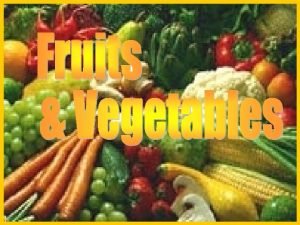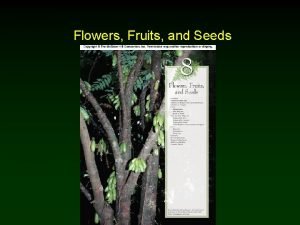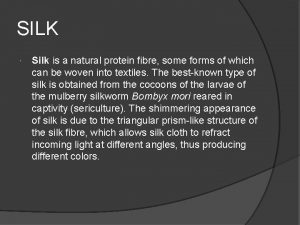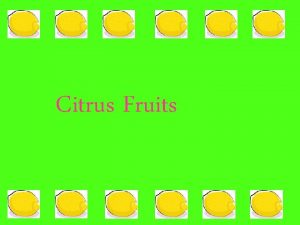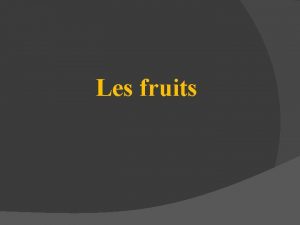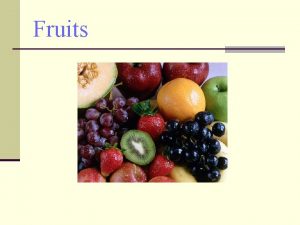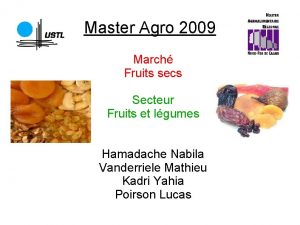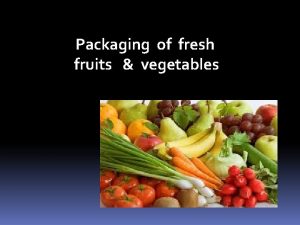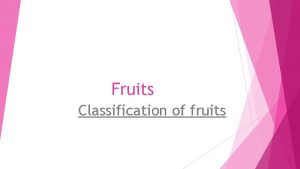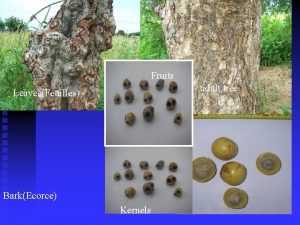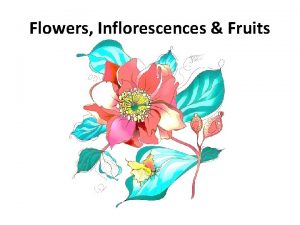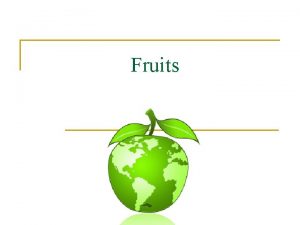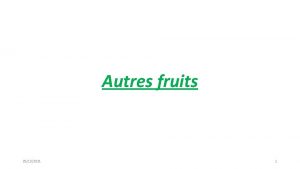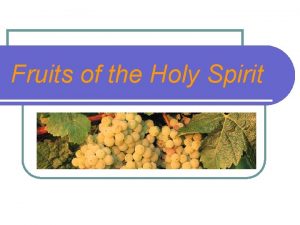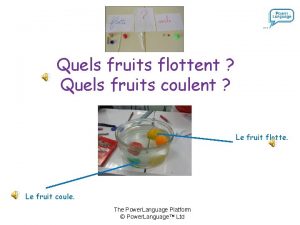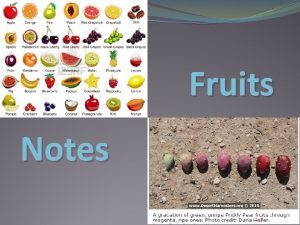The sweetness of fruits comes from a natural






























- Slides: 30


The sweetness of fruits comes from a natural form of sugar called fructose. Fruit is very versatile, appropriate for puddings, pies, and jellies, salads, appetizers, eaten as snacks, and served in soups. Fruits can cut the richness of meats like pork and duck, and enhances the delicate flavors of fish and veal. The scientific definition of a fruit is ‘an organ that develops from the ovary of a flowering plant and contains one or more seeds. ’ The culinary definition, however, limits fruits to those foods containing a high sugar content.

Winter fruits include citrus fruits and apples. Fruits are classified by growing season and location. The 3 main groups of fruit are summer, winter, and tropical. Citrus fruits are characterized by thick skins, aromatic oils, and segmented flesh. They are abundant in vitamin C. The most common citrus fruits are oranges, grapefruits (white and sweeter pink varieties), lemons, limes, tangelos, and tangerines. The flavor of citrus fruits range from very sweet oranges to very tart, sour lemons.

Apples are a widely available winter fruit, and among the most commonly used of all the fruits. Carpels are semitransparent pods that contain seeds near the core. They do not soften during cooking. The sweet and semi-firm textures of the Red and Golden Delicious apples are best for ‘eating’. The crisp and tart apples like the Jonathan and Granny Smith are best for baking, as they hold their shape well during cooking. The semi-tart Mc. Intosh, Rome, and Winesap apples are excellent for applesauce.

Berries are highly perishable, tender, and fragile. Handle them as little as possible and serve them as soon as possible. Varieties include blueberries, raspberries, blackberries, boysenberries, and strawberries. Summer fruits include berries, cherries, grapes, melons, peaches, nectarines, plums, and pears. Cherries range in color from the light red of the Queen Anne to the very dark, almost black Bing cherry. Flavors range from very tart cherries, best for baking, to the very sweet and usually darker cherries best for eating fresh. Cherries can be served fresh or cooked; they can be frozen or canned or pickled and candied, like the maraschino cherry.

Cherries, along with plums, peaches, nectarines, and apricots are called DRUPES. Drupes all have a central pit enclosing a single seed. Peaches have a distinctive fuzzy skin. There are two categories of peaches: Apricots have fuzzy In CLINGSTONE peaches, the pit sits tightly against the meat and is tougher to remove, but skin like peaches, but are usually smaller, the meat is sweeter, darker in color and juicier. slightly drier and more It is mostly used in the making of jellies and orange in color. jams, and is not commonly found in groceries Nectarines are also or markets. In FREESTONE peaches the pit sits loosely against the meat and is much easier to similar to peaches, but with a smooth skin remove. Grown in the southern states, like and flesh the same Georgia, they are lighter in color, firmer in texture of plums. texture, and tend to be larger than clingstone.

Popular sweet melons are honeydew and cantaloupe (muskmelon). Characterized by their tan, green, or yellow skin, the rind is tough and the flesh is flavorful. The network of seeds in the middle are taken out before eating. Unlike sweet melons, watermelons have a smooth, thick green skin and are often much larger in size. The seeds are scattered throughout the melon. Plums have a firm flesh and range in shades of green, red, and purple. There are two categories: dessert and cooking. Cooking plums are generally drier and more acidic than dessert plums. Some cooking plums grow wild.

Grapes are technically berries that grow in clusters on vines, but because they come in so many varieties with so many uses, they are grouped separately. They are available with or without seeds. We eat them, cook with them, and make wine with them. California Seedless and Napoleon Red are two common varieties. White wines complement the flavor of fish and poultry; red wines complement the flavor of beef. Pears have a sweet taste and a smooth juicy flesh. Common varieties are Bartlett, Bosc, or d’Anjou (small dark red or green). Pears are often picked early, while the flesh is still very firm and grainy. Place them in a paper bag and allow them to ripen at room temperature.

POMEGRANATE PAPAYA Tropical fruits are named for the climatic conditions under which they grow, and include figs, dates, kiwis (fuzzy skin with bright greencolored flesh and tiny edible seeds), mangos (thick-skinned with a light yellow flesh and spicy-sweet flavor), bananas, papayas (their vitamin C content increases as they ripen), pomegranates, passion fruit, pineapple, and coconuts (coconut milk is not the juice from the center, but a simmered mixture of water and coconut meat). Bananas are high in nutrients and are picked green and allowed to ripen during transport. Green bananas can be cooked; very overripe bananas can be used in baking. MANGO

The parts of the vegetable plants we eat include the leaves, fruit, stems, roots, tubers, seeds, and flowers. They are eaten cooked more often than fruits are, and have a lower sugar content. In flower vegetables, the flower or FLORET part of the plant and the stems are eaten. Only the tender flesh at the base of each globe artichoke outer leaf is eaten, scraped off on the teeth. Then the thistle-type ‘choke’ is removed and the ‘heart’ of the artichoke is exposed. Artichokes are sometimes considered a stem vegetable. The thick, waxy leaves of the cabbage plant stand up well in stir-frying and in soups. Cut broccoli stems lengthwise to ensure cooking times for stems and florets are the same.

It is believed that cruciferous vegetables may lower the risk of certain kinds of cancer. These vegetables are from the cabbage family and include cabbage, cauliflower, Brussels sprouts, kale, broccoli, mustard greens, collards, rutabagas and turnips.

Avocados have leathery green or black skin with a buttery flavor. They should be served with lime or lemon juice to prevent the flesh from turning brown. Guacamole (gwak-ah. MOE-lee) is a traditional Mexican dip using mashed avocados as the main ingredient. Slicing cucumbers have smooth skins and are long, round cylinders with a high water content. Pickling cucumbers (prickly skin)are best used for making sweet or dill pickles. Ones that feel heavy for their size are likely to be crisper. Smaller cukes have fewer seeds. Eggplant is a tear-shaped, purple-black vegetable with a glossy skin and firm flesh, sometimes used as a good replacement for meat. Asian eggplant, a more slender variety, is typically sweeter. It is always served cooked. Babaganoush (BAH-bah-gahn-OOSH) is a Middle Eastern dip using eggplant as the main ingredient.

Bell or sweet peppers are named for their shape. All varieties start out green, and change colors to red, green, yellow, cream, or purple as they ripen. Chili peppers are smaller and hotter. The seeds are the hottest part. Butternut, acorn, spaghetti, banana, hubbard, and Tomatoes are a type of pumpkin are types berry, ranging in color of winter squash. Crookneck, and from green, to yellow, zucchini are types to bright red. Large, green tomatoes can be of summer squash with soft skin and fried. Vine-ripened Tomato products include smaller seeds that tomatoes have the can both be eaten. sauce, paste, and ketchup. best flavor.

The light-green leaves of iceberg lettuce are tightly packed together; the heaviest heads being the most compact. Remove the core before storage for a longer shelf life. Both romaine and leaf lettuce are loosely packed; the leaves grow upward in bunches and their edges are slightly ruffled. Escarole → Romaine Red & green leaf lettuce There are several types of ‘greens’ used in cooking, including mustard greens, escarole, and spinach. They usually have a more bitter, stronger flavor than the lettuces and are very high in nutrients.

Once the seed vegetables are picked, they begin to convert their natural sugars to starch. They lose their sweetness. Peas Green beans Haricot verts Fresh beans include green beans, yellow wax beans, and French haricot verts (HAIR-ee-ko VAIR). They are all eaten in the pod… or long, outer shell. Corn and popcorn, grown for its small ears and pointed Fava Beans Lima Beans kernels that explode Broad beans are removed when heated. from the pod before cooking. They are toxic when raw.

Root vegetables are plants that have a single, large edible root that extends down into the ground and provides nutrients to the part of the plant above ground. Carrots contain a large amount of carotene, a pigment easily convertible to vitamin A. The leaves and root of beets are both edible. Large beets may have a woody texture. Pickled beets are zesty. Peppery-flavored radishes range in color from bright reds to pale cream, making them a good garnish. When young and fresh, half-white, half-purple turnips range in flavor from very sweet to a little peppery; older ones can be hot and bitter. The flesh is white; the greens are edible.

White onions have the sharpest, cleanest flavor, best for slicing on hamburgers. Flattened yellow onions are the most common and the least expensive. Use these for most recipes and for onion rings. Very round yellow, red, and white onions are less “hot”, somewhat sweeter and crisper. All varieties have a pungent flavor and aroma and are used as seasonings. Pearl onions have very small bulbs. Green onions, also called scallions, are common onions Leeks look like large pulled when Vidalia onions: green onions. They have the sweet onions only immature. from South Georgia mildest flavor of all onions. Mild-flavored shallots are shaped like small bulb onions, but separate into cloves when broken apart. Garlic is separated into cloves and peeled. Some believe garlic has medicinal qualities.

Tubers are enlarged, bulbous roots capable of generating a new plant. They are actually fat, underground stems. Like several of the seed vegetables, these are high in starch. Potatoes are the most popular vegetable and very versatile, able to be prepared by baking, boiling, frying, deepfrying, and microwaving. There are several varieties of potatoes, served daily in over 60% of U. S. households. Sweet potatoes have a darker flesh than a white potato due to a higher sugar content. The thick skin is not usually eaten. Yams are similar to sweet potatoes, but not as sweet. Its flesh ranges in color from deep red to creamy white.

White oval-shaped potatoes, a variety called Russets, are grown for baking. As they become tender, the flesh of the potato becomes mealy. The skin is the only thing that helps this potato maintain its shape. They are the most expensive potato. Red potatoes hold their shape well when cooked, so are best prepared by boiling. These can be boiled, and then sliced for frying or diced for potato salad. Round white potatoes can be prepared by either baking or boiling.

Celery has a high water content and is very crisp. The ‘bunch’ is called a STALK. An individual piece is called a RIB. Celery is often served ‘stuffed’ with cheese or peanut butter. Asparagus Inexpensive Button Mushrooms are a family of ‘fungi’. Purchase from reliable sources to avoid poisonous varieties. Morel; resembles truffle with earthy nutty flavor Shitake; 10” cap Portabella; largest mushroom with meaty flavor Enoki; resembles bean sprouts and fruity flavor Chanterelle with nutty flavor

The USDA (United States Dept. of Agriculture) has a grading system for fruits and vegetables to indicate quality, but it is not mandatory in all cases. USDA grades, from highest to lowest, are U. S. Extra Fancy, U. S. No. 1, U. S. No. 2, and U. S. No. 3. Higher qualities are indicative of excellent colors and flavors and uniformity of shapes and sizes. Produce grown by hydroponic farming methods (grown in nutrient-enriched water under regulated light and temperatures) is not as flavorful. When purchasing canned fruits, you may select from those packed in their own juice (no sugar added), those packed in light syrup (a small amount of sugar added), or those Purchasing produce in the offpacked in heavy syrup (a larger season is more expensive. amount of sugar added).

DO NOT wash vegetables until you are ready to use them. Moisture causes spoilage. Certain fruits (incl. apples, bananas, melons, and avocados) emit ethylene gas which causes fruits to ripen. These should be stored in a sealed container. Unripe produce will continue to ripen in cool, dry places. Refrigerate ripened fruits and vegetables in ventilated plastic or paper bags or in the crisper section. Refrigerating bananas will darken the skins, but delay the ripening of the fruit. Wash produce before using. Refrigerate Yukon Gold potatoes, which are used like other round potatoes, but have a yellow flesh and buttery flavor. Do not refrigerate other potatoes, as the starch will turn to sugar. Store potatoes and onions in a cool, dry place…. Unpeeled. Potatoes exposed to light turn a green color, and develop a bitter taste.

Some fruits and vegetables naturally contain the enzyme polyphenoloxidase (pol-lee-fen-il-OX-ee-days) that, when combined with oxygen in the air react to cause discoloration. This process begins as soon as the skin or peel of the produce is removed. Tearing lettuce instead of cutting it with a knife, deters browning. Apples, pears, bananas, grapes, potatoes, lettuce, and avocadoes are all fruits and vegetables that will turn brown as the flesh of the produce is exposed to oxygen. Lemon juice, vinegar, powdered ascorbic acid (Vitamin C)…all used full strength or diluted with water, will delay and/or slow the enzymatic browning. Even adding salt and/or covering them with water will help.

Cooking fruits and vegetables results in noticeable changes: 1. COLOR of green vegetables, from the chlorophyll pigment, turns to dull olive green if overcooked or exposed to acid. A small amount of baking soda will brighten the green color, but destroys nutrients. A small amount of acid from lemon juice or vinegar added to red vegetables such as cabbage or beets that contain the carotenoid or anthocyanin (an-thoe-SIGH-ah-nin) pigments restores bright colors damaged by cooking these vegetables in water containing certain minerals. An alkali such as soda causes a blue-green color in red vegetables. 2. TEXTURE changes as heat softens cell walls, making the fruit and vegetables more tender. Overcooking them, however, may cause them to be mushy. 3. FLAVOR is released during cooking, making them more pronounced, but overcooking fades or causes unpleasant flavors. Fruits flavors mellow when heated, and become less acidic. MACEDOINE (mass-ee-dohn): mixture of fruits or vegetables

1. Use as little water as possible while cooking vegetables and fruits, and serve them with the liquid as many of the nutrients are dissolved in it. (All vitamins except A, D, E, &K) Leftover liquids can be used in soups and mashed potatoes. 2. Cut the vegetables and fruits in large pieces rather than very small ones. Nutrients leave the food item Fruits and vegetables are excellent through the cut surfaces. sources of vitamins ( like A & C), minerals (such as potassium), and Nutrients are fiber. They are low in fat and 3. Don’t overcook! destroyed by exposure to heat, sodium and have no cholesterol. Bananas are an excellent source of potassium…a mineral needed to prevent cramping of leg muscles. especially over long periods of time. Cook fruits and vegetables as quickly as possible.

FRYING is a popular method of preparing vegetables. Potatoes and onion rings can be deep fat fried. STIR-FRYING requires a large, hot surface, like a wok. Chopped onions, garlic, or green pepper might be SAUTÉED in butter. BLANCHING or PARBOILING, partially cooks vegetables or fruits in boiling water. This allows the skins of produce such as peaches or tomatoes to be easily removed. a la king: served in cream sauce with vegetables Pierce skins of whole potatoes before MICROWAVE COOKING to avoid bursting. Peppers, sweet corn, mushrooms, bananas, tomatoes… benefit with a flavor burst from being GRILLED OR BROILED.

SIMMERING is a method of slow-cooking in liquid. Keep the temperature at or just under boiling. STEAMING minimizes nutrient loss. It may take a little longer than placing the food directly in a liquid, however. There a variety of steamers available on the market. BAKING is cooking in dry heat in an oven. TEMPURA is a Japanese method of breading and deep-frying vegetables. GLAZING is a finishing technique. A small amount of sugar or syrup is added to or brushed over the vegetable to BOUQUETIERE: a mix of fresh vegetables, in season give it a glossy appearance as it heats. JARDINIERE: diced, mixed vegetables POACHING, also called stewing, is a method of cooking in liquid. The goal is retention of shape. Use just enough water to cover fruit, and add water for a little sweetness and help in retaining shape.

Popular fruit sauces include applesauce or a fresh berry coulis (cool-LEE) which is a sauce made from a purée of vegetables or fruit that can be served hot or cold. Begin by cooking the fruit in liquid, such as water, until the fruit has broken down. Add a sweetener such as sugar, honey, or syrup. Once the sauce has cooled, spices or other flavorings can be added as desired. A purée will be smooth if put in a blender or through a sieve. A compote is stewed fresh or dried fruit, fruit cooked in water and sugar (a syrup), and served as a hot or cold dessert. Chutney is any relish type mixture made from chopped fruits or vegetables.

The “relish tray” has become standard fare on many tables and buffets. Raw vegetables (including cucumbers that have been made into sweet and dill pickles) and olives (black, green, stuffed, etc. ) are high in nutrients and very colorful. Their crisp texture adds variety to any meal. They make a low-calorie, highfiber snack. Crudités (croo-dee-TAY): A French term for raw vegetables served as a relish. Wasabi: Japanese horseradish condiment

 The sweetness of fruit comes from
The sweetness of fruit comes from Monocot and dicot fruits
Monocot and dicot fruits Sweetness and light arnold
Sweetness and light arnold Majestic sweetness sits enthroned
Majestic sweetness sits enthroned Majestic sweetness
Majestic sweetness Erythritol production process
Erythritol production process First comes love, then comes marriage
First comes love, then comes marriage Silk is a natural protein fiber some forms of which can be
Silk is a natural protein fiber some forms of which can be Natural capital and natural income
Natural capital and natural income Natural hazards vs natural disasters
Natural hazards vs natural disasters Một số thể thơ truyền thống
Một số thể thơ truyền thống Tư thế ngồi viết
Tư thế ngồi viết ưu thế lai là gì
ưu thế lai là gì Trời xanh đây là của chúng ta thể thơ
Trời xanh đây là của chúng ta thể thơ Thẻ vin
Thẻ vin Tỉ lệ cơ thể trẻ em
Tỉ lệ cơ thể trẻ em Từ ngữ thể hiện lòng nhân hậu
Từ ngữ thể hiện lòng nhân hậu Các châu lục và đại dương trên thế giới
Các châu lục và đại dương trên thế giới Diễn thế sinh thái là
Diễn thế sinh thái là Ví dụ về giọng cùng tên
Ví dụ về giọng cùng tên Thế nào là hệ số cao nhất
Thế nào là hệ số cao nhất Bàn tay mà dây bẩn
Bàn tay mà dây bẩn Lời thề hippocrates
Lời thề hippocrates Hát kết hợp bộ gõ cơ thể
Hát kết hợp bộ gõ cơ thể Hổ đẻ mỗi lứa mấy con
Hổ đẻ mỗi lứa mấy con Mật thư anh em như thể tay chân
Mật thư anh em như thể tay chân đại từ thay thế
đại từ thay thế Tư thế worm breton là gì
Tư thế worm breton là gì Vẽ hình chiếu vuông góc của vật thể sau
Vẽ hình chiếu vuông góc của vật thể sau Voi kéo gỗ như thế nào
Voi kéo gỗ như thế nào Thế nào là mạng điện lắp đặt kiểu nổi
Thế nào là mạng điện lắp đặt kiểu nổi
